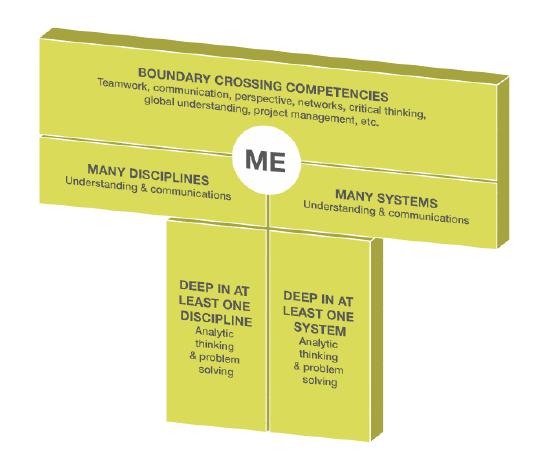Skills Development & Utilization
It is becoming more and more evident that this globally interconnected and constantly changing world needs so-called “T-shaped” people. T-shaped professionals possess deep disciplinary knowledge along with an understanding of the bigger picture, the context of use, and the ability to communicate across social, cultural, and economic boundaries (See picture. Source.).

The two vertical bars of the "T" represent disciplinary specialization and the deep understanding of one system. Systems describe major services, such as transportation, energy, education, food, and healthcare, that impact quality of life. These systems are comprised of interconnected components of people, technology, and services. To understand a system, one must know how it functions from the bottom to top in order to address challenges.
The defining characteristic of the “T-shaped professional” is the horizontal stroke, which represents their ability to collaborate across a variety of different disciplines. To contribute to a creative and innovative process, one has to fully engage in a wide range of activities within a community that acknowledges their expertise in a particular craft or discipline and share information competently with those who are not experts.
This implies a change in emphasis from being a specialist or a generalist to being a specialist AND a generalist. Most knowledge workers are trained and work as an I-shaped person. They are focused on being productive in one field and a particular skill set in which they gain knowledge. Organizations nowadays require employees to collaborate with different disciplines, to handle information from multiple resources, and to contribute to organizational practices in an innovative way.
The same applies to service organizations. To dynamically fulfill the demand to service each unique request, knowledge workers need to collaborate with other knowledge workers or generalists to tap into the various skills available in the organization.
A T-shaped person taps into both the left and right brain. Daniel Pink explains the need for "whole-brainers" (as opposed to left-brainers and right-brainers) in his book A Whole New Mind: “We are moving from an economy and a society built on the logical, linear, computerlike capabilities of the Information Age to an economy and a society built on the inventive, empathic, big picture capabilities of what’s rising in its place, the Conceptual Age”. From a brain perspective, left-directed thinking is analytical, sequential, and textual, while right-directed thinking is more holistic, intuitive, and non-linear. A T-shaped person integrates both left- and right-brain thinking. Having a staff of T-shaped people gives us much greater flexibility in the utilization of our resources.
In his book, Now Discover Your Strengths, Marcus Buckingham argues that in their training of employees, organizations focus too much on correcting weaknesses, while there are huge gains to be made by building on employees’ strengths. By identifying strengths already present in the organization, employees can be utilized in the most suitable positions, where they can acquire skills easily, which in turn helps to improve employee morale and reduce turnover. By focusing only on the left brain (developing deep but narrow analytical expertise), organizations underutilize the other skills present in each employee. In fact, Buckingham's research implies that companies only use 40% of the skills they employ.
An Intelligent Swarming system creates T-shaped people by inviting faster and easier knowledge transfer between people. Generalists learn specialist knowledge and specialists gain generalist skills. By providing visibility to work relevant to the individual and allowing people to select work in areas they would like to learn about, the Intelligent Swarming Practices directly build T-Shape capabilities. Time to proficiency is reduced for folks who are expanding their skills. Intelligent Swarming also helps an organization work like a T-shaped person by bringing together the needed skills for any situation.
